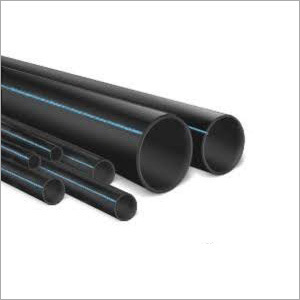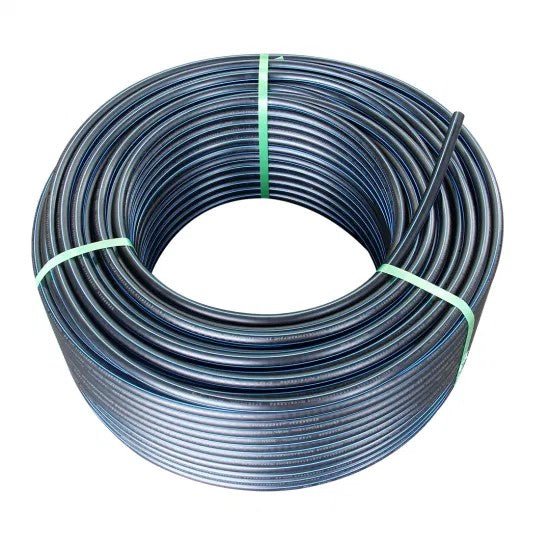Explore the Production Process Behind High-Quality HDPE Pipe and Its Applications
The manufacturing procedure of premium HDPE pipelines is detailed and systematic. It starts with the selection of basic materials that enhance performance. Following this, ethylene undertakes polymerization to form resin, which is after that formed with extrusion. Quality assurance is paramount, guaranteeing that the final item meets strict standards. However, the trip of HDPE pipelines does not finish with manufacturing. Their applications across numerous industries disclose a broader relevance worth checking out.
Recognizing HDPE: Residences and Advantages

High-density polyethylene (HDPE) is a flexible thermoplastic understood for its sturdiness and resistance to numerous ecological variables. This material displays exceptional tensile stamina, making it ideal for demanding applications. Its low-density framework adds to a lightweight item, helping with simplicity of handling and setup. HDPE also showcases impressive resistance to chemicals, which reduces deterioration when revealed to harsh materials.
The material's low dampness absorption additionally enhances its durability, making it optimal for usage in pipelines and storage space containers. Additionally, HDPE is immune to ultraviolet (UV) radiation, ensuring that products preserve their honesty also when revealed to sunlight. Its flexibility allows for the development of elaborate forms without compromising strength. The green nature of HDPE, usually originated from recycled products, includes in its appeal, promoting lasting techniques in production. In general, these buildings and advantages make HDPE a favored option for different industrial and customer applications.
Raw Product Option for HDPE Manufacturing
The selection of resources for HDPE production is important to validate the final item meets the desired specifications and quality standards. High-density polyethylene (HDPE) is mainly produced from polymerized ethylene, originated from nonrenewable fuel sources such as gas or petroleum. The high quality of these feedstocks greatly influences the mechanical and thermal residential or commercial properties of the last HDPE.
Ingredients also play a considerable role in enhancing HDPE's performance, consisting of anti-oxidants, UV stabilizers, and colorants, which improve resilience and resistance to ecological variables. The choice process should take into consideration not only the chemical composition of the raw products yet additionally their processing characteristics to assure reliable production.
In addition, the sourcing of resources ought to focus on sustainability and compliance with ecological regulations, as responsible practices are crucial in today's market. Eventually, cautious raw material option lays the structure for generating high-grade HDPE pipes suitable for varied applications.
The Extrusion Process: Shaping HDPE Pipeline
The extrusion process plays an essential role in forming HDPE pipelines, beginning with precise product preparation methods that assure ideal circulation and uniformity. Equally crucial is the design of the die, which straight influences the final dimensions and surface area quality of the pipe. With each other, these aspects add significantly to the effectiveness and high quality of HDPE pipeline manufacturing.
Product Prep Work Strategies
Reliable manufacturing of HDPE pipelines starts with precise product prep work strategies, particularly the extrusion procedure. During this phase, high-density polyethylene material is initial dried out to get rid of moisture, making sure excellent flow attributes. The resin is after that fed right into the extruder, where it undertakes home heating and melting, changing right into a viscous state. This heating procedure is very carefully controlled to keep the product's honesty and performance. The molten HDPE is forced through a die, forming it into a continuous pipeline type. Correct temperature level monitoring during extrusion is crucial, as it directly affects the product's buildings and the end product high quality. Once shaped, the HDPE pipeline is cooled down and cut to defined sizes, prepared for subsequent handling and applications.
Die Style Relevance
Accuracy in die style plays a necessary function in the extrusion procedure of HDPE pipes. The die acts as the final shaping device, straight affecting the pipe's dimensions, wall surface density, and surface coating. A properly designed die assurances uniform material circulation, decreasing defects such as abnormalities and weak points. The geometry of the die should be optimized to fit the specific properties of HDPE, including its viscosity and thermal habits during extrusion. Furthermore, the cooling rate of the product as it goes through the die can substantially affect the pipeline's architectural integrity. As a result, investing in sophisticated die technology is essential for producers intending to generate top notch HDPE pipelines that satisfy sector standards and consumer assumptions.
Quality Assurance Procedures in HDPE Production
Different aspects influence the top quality of HDPE pipe production, efficient top quality control actions are important to guarantee consistency and reliability in the last product (hdpe pipe in stock Midland TX). Secret quality assurance practices consist of rigorous product examination, validating that the raw polyethylene fulfills well established criteria for pureness and density. Throughout the extrusion procedure, specifications such as temperature, pressure, and cooling time are very closely monitored to maintain dimensional accuracy and architectural honesty
Furthermore, post-production testing is important; suppliers often perform hydrostatic tests to assess the pipeline's strength and resistance to stress. Visual examinations for surface area issues additionally enhance quality control. Qualification from pertinent standards companies, like ASTM or ISO, gives an extra layer of reputation. By carrying out these extensive quality control measures, makers can minimize flaws, boost efficiency, and ensure that the HDPE pipes fulfill the certain requirements of various applications, inevitably bring about client complete satisfaction and count on the product.
Applications of HDPE Pipeline Across Industries
HDPE pipelines are made use of across numerous markets because of their durability and versatility. In water circulation systems, they assure efficient shipment, while in wastewater management, they give dependable options for waste transportation. In addition, farming watering networks take advantage of HDPE's resistance to corrosion and flexibility, making it a suitable selection for modern-day farming practices.

Water Circulation Systems
A considerable number of sectors depend on high-density polyethylene (HDPE) pipes for reliable water circulation systems. Understood for their resilience and get more info resistance to rust, HDPE pipelines are widely utilized in community supply of water networks, farming watering, and commercial applications. Their lightweight nature promotes easy handling and installation, minimizing labor costs and time. In addition, HDPE pipelines can accommodate various pressure degrees, making them ideal for both reduced and high-pressure systems. American Plastics HDPE Pipe for Oilfield. The adaptability of the product permits for smooth assimilation right into existing framework, minimizing the need for comprehensive excavation. Additionally, HDPE's resistance to chemical seeping assurances that the water provided stays risk-free and tidy, making it an excellent option for maintaining the quality of drinkable water throughout various fields
Wastewater Monitoring Solutions
Reliable water distribution systems likewise lead the way for ingenious wastewater administration services, where high-density polyethylene (HDPE) pipelines play a substantial duty. Popular for their sturdiness and resistance to corrosion, HDPE pipes are suitable for transporting wastewater in different setups. Their flexibility enables for very easy installment in complex environments, reducing the requirement for extensive excavation. Furthermore, HDPE's smooth indoor surface area lowers rubbing, boosting circulation rates and effectiveness. These pipelines are also resistant to chemical leaching, making sure that pollutants do not jeopardize the surrounding atmosphere. Industries, municipalities, and treatment facilities increasingly count on HDPE pipelines for their integrity and longevity, making them a recommended selection for modern-day wastewater administration systems. This versatility highlights the critical value of HDPE pipelines across numerous applications.
Agricultural Irrigation Networks
Agricultural watering networks benefit substantially from using high-density polyethylene (HDPE) pipes, which offer efficient and dependable water shipment to plants. HDPE pipelines are lightweight, making them very easy to deliver and set up, while their flexibility allows for numerous setups in diverse surfaces. These pipes show outstanding resistance to corrosion, chemicals, and UV radiation, making certain resilience in rough agricultural environments. Furthermore, their smooth interior surface area minimizes rubbing loss, optimizing water circulation and minimizing energy expenses associated with pumping. The durability of HDPE pipelines, commonly exceeding half a century, adds to reduce maintenance and substitute expenditures. Farmers increasingly depend on HDPE pipelines to enhance irrigation effectiveness and advertise lasting farming methods, inevitably leading to improved plant returns and resource conservation.

Future Fads in HDPE Pipeline Technology
As the need for sustainable and reliable facilities expands, innovations in HDPE pipeline technology are poised to transform different industries. Arising patterns consist of the integration of clever technologies, such as sensing units and IoT capabilities, which help with real-time monitoring of pipeline problems, decreasing upkeep costs and protecting against leakages. Additionally, the development of sophisticated manufacturing strategies, such as 3D printing, is making it possible for the manufacturing of complex, personalized pipe layouts that accommodate particular project demands.
Furthermore, the concentrate on recycling and circular economic situation practices is driving the technology of HDPE pipes made from recycled materials, improving sustainability. Improved jointing techniques, such as electro-fusion and mechanical installations, are additionally boosting installment performance and integrity. The expanding emphasis on ecological policies is pressing producers to adopt greener manufacturing processes, ensuring that HDPE pipes not just fulfill market standards but additionally cultivate a more sustainable future for facilities growth.
Frequently Asked Questions
How Does HDPE Contrast to Various Other Plastic Products?
HDPE exceeds several other plastic products pertaining to durability, chemical resistance, and flexibility. Its reduced density and high tensile strength make it excellent for various applications, commonly going beyond alternatives in both performance and durability.
What Are the Environmental Effects of HDPE Manufacturing?
The environmental influences of HDPE production consist of greenhouse gas discharges, power usage, and potential contamination from making procedures. Additionally, improper disposal can lead to dirt and water contamination, elevating concerns about lasting eco-friendly impacts.
Can HDPE Pipeline Be Reused?
Yes, HDPE pipelines can be recycled. Lots of centers accept used HDPE for processing, transforming it right into brand-new items. This recycling contributes to sustainability efforts, minimizing plastic waste while saving resources and power in the manufacturing cycle.
What Is the Life-span of HDPE Water Lines?

How Do Temperature Variants Influence HDPE Pipeline Efficiency?
Temperature level variants significantly influence HDPE pipeline efficiency, affecting adaptability and strength. Heats can cause softening, while reduced temperature levels may create brittleness, inevitably influencing the pipe's sturdiness and suitability for numerous applications in varied environments.